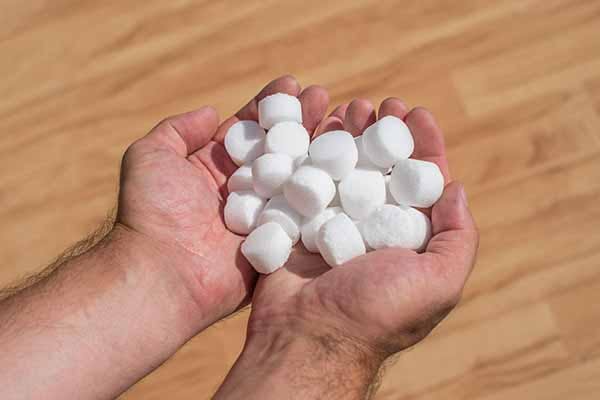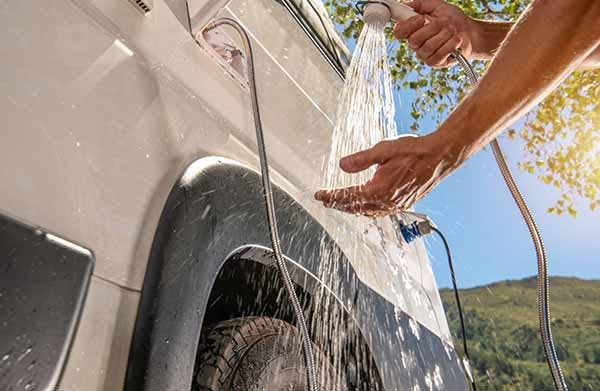June 2022
Types of Water Softeners: What You Need to Know
There are many types of water softeners — so many, in fact, that it's no wonder if you may be confused about the best water softener choice for you.
But why would you be thinking about softening your water? Perhaps you're concerned about what the hard water in your home is doing to your appliances, water pipes, clothing, hair, and skin. That’s because the mineral content in hard water includes heavy minerals, such as calcium, iron, and magnesium that can do damage.
Many questions come to mind if you're considering installing a water softener system, not least of which is whether you need one. We'll talk about the different types of water softeners, explain your options, and answer your questions about the types of water softeners that are available.
How Do I Know If I Need a Water Softener?
Homeowners install water softening systems because they have hard water. Signs of hard water include:
- Limescale build-up around faucets, in water lines, and appliances
- Lathering of soaps requires excessive soap or detergent
- Dry, irritated skin
- Dingy clothes
- Mineral and rust stains or discoloration
- Spots on clean glassware and dishes
While hard water isn't harmful, the mineral content of scale build-up can reduce water pressure by clogging water lines, faucets, and showerheads. The scale deposits can also decrease the lifespan of water heaters, dishwashers, washing machines, and kitchen appliances.
Experts measure water hardness in calcium carbonate grains per gallon (GPG). Water hardness test readings under 3.5 GPG are considered soft water. A reading of 7 GPG and above indicates hard water, and above 10.5 very hard water. If you suspect you have hard water problems, DIY water hardness test strips are available online from Amazon or in home improvement stores. You can also contact your county office or water utility to schedule a test.
How Do Water Softeners Work?
Depending on the water softener system you choose, the operating systems will vary. However, the underlying principles are the same. Water softeners draw out the heavy minerals in the water through an ion exchange process or neutralize the minerals and decrease their solubility. As a result, home water softeners remove calcium, magnesium, iron, and other minerals from drinking water.
What Different Types of Water Softeners Are Available?
In general, there are four basic types of water softeners: salt-based, salt-free, dual-tank, and magnetic water softeners.
Salt-Based Water Softeners
The most common type of water softener, salt-based water softeners, comes in many sizes for many different situations. They remove hard water minerals through an ion exchange system that draws them through a resin bed and exchanges them for sodium ions.
The salt-charged resin beads capture the calcium and magnesium ions and release the sodium ions. The resulting chloride solution enters the wastewater system, eventually emptying into the environment.
Dual-Tank Water Softeners
A dual-tank water softener uses a salt-based softener and works the same way as a salt-based water softening system. One tank is the resin tank, and the other is the brine tank. When the sodium-covered resin beads in the resin tank become loaded with hard mineral deposits, the brine tank rinses and recharges them.
Salt-Free Water Softeners
The name says it all — salt-free water softeners don't use salt to remove hard water minerals; they use a template-assisted crystallization (TAC) system and potassium chloride instead. Technically not a water softener system at all, it's actually a descaler. A TAC works by detaching mineralized crystals and preventing them from bonding to any part of your water delivery system.
TAC systems use treated resin beads to convert hardness ions to scale-resistant crystals. When agitated, the microscopic crystals precipitate out to permit the formation of new crystals. Once formed and released from the beads, the crystals are insoluble particles that do not form surface scaling.
Here are just a few benefits of the HomeWater whole-house water filtration system:
- Unlike installing a regular water softener, you won’t need to connect to your electricity since the EZChange Salt-Free Softener uses a molecular bonding reaction.
- TAC systems are more environmentally friendly. That’s because they’re salt-free. This is good news for Californians; some California municipalities have banned the use of salt-based water softeners because too much salt brine can enter the water table.
- TAC systems usually make your water taste better since no salt is used to soften it.
Magnetic Water Softeners
A magnetic water conditioner system is not a true water softener system; it's more of a lime de-scaler. Magnetic "water softeners" use an electromagnetic coil. As water flows through the magnetic field, the structure of calcium and magnesium ions changes to a crystalline structure, allowing them to precipitate out of the water.
How Do Ion Exchange Water Softeners Work?
Most household water softeners are ion exchange devices. In water softener systems, ion exchange is a chemical process that swaps positive ions in the water for negative ones from the resin.
The exchange of ions takes place within the resin tank of the water softener system. When water flows into and through the water tank, the freshwater makes contact with sodium ion-covered resin beads — the flowing water exchanges the hardness-related ions for the sodium ions.
An ion exchange system has three functional areas: water intake, piping, and control valves. The resin material is the most critical part of the system. The ions of the resin material can be negatively or positively charged, which is how they attract the mineral ions in hard water.
The regenerant distribution system (RDS) holds the regenerant solution, usually salt-based. The regeneration cycle revitalizes the depleted resin beads' charge, with the RDS recharging the beads.
Retention elements capture and contain the unwanted calcium and magnesium ions, eliminating them from your drinking water.
What Size Ion Exchange Water Treatment System Do I Need?
To determine the size of the ion exchange system you want to install, the first thing to know is the type of ion exchange system you need.
You'll also need to know what you're treating and how much of it. Your water test results will provide the answer to this question. Your water hardness, measured in grains per gallon (GPG), is important in calculating the size of your water softener system.
Also, know how much treated water you'll need. An ion exchange water-treatment system is a whole-house system — you won't need to treat water for outdoor irrigation. A good water usage rule of thumb is to estimate 75 gallons of water per person per day.
You'll also need to determine your water flow rate and water pressure, because ion exchange systems require a minimum pressure and water flow.
Your next decision is whether or not you'll install an automatic system to back-flush the resin bed or resin tank. This is critical because the resin beads require regular flushing (also called backwashing) to work effectively.
A Reverse Osmosis System: What Is It and How Does It Work?
Utilizing a semi-permeable membrane, a reverse osmosis (RO) system is a whole-house water filtration system that removes many contaminants from your drinking water. Under pressure, the filtration system's membrane separates dissolved solids and other contaminants in your water. Because the water flows in the opposite direction of the natural osmosis process, it's called reverse osmosis.
Reverse osmosis filtration systems remove water contaminants and sodium, chloride, copper, and lead. It may also help reduce calcium, nitrates, sulfites, and magnesium. In addition to soluble salts and minerals, whole-house water treatment via reverse osmosis also removes metal ions.
Calcium and magnesium will build up over time on the semi-permeable membrane if you have hard water. In addition, the membrane is a fragile component of a reverse osmosis system that requires regular maintenance. Adding a water softener to your RO system will alleviate additional wear and tear on your installation.
Can I Get an RV Water Softener and How Does It Work?
No doubt you've experienced the frustrations of hard water on the road if you have an RV. Not only does hard water play havoc with showering and dishwashing, but hard water deposits also gum up the plumbing in your RV, which can lead to costly repairs.
Fortunately, several different water softeners for RVs, travel trailers, and campers are available — portable or installed. The most common water softening system is an ion exchange system that works similarly to whole-house ion exchange water softeners.
An ion exchange system uses a brine solution to trap calcium and magnesium ions that are ultimately filtered out. Periodically, the system has to be recharged with a fresh saltwater solution, usually overnight.
Other water softening systems include electrical, magnetic, and chelation systems.
What Is an On-the-Go Portable Water Softener?
Portable water softeners are perfect if you have a camper, RV, or even a tiny house. Designed to work with an ordinary hose connection, an OTG water softener system gives you the same protection from the limescale build-up as your whole-house water softener system does.
Do I Need a Certain Type of Water Softener For Well Water?
Of course, it depends on where you live, but well water tends to be hard water. The best softening solution is template-assisted crystallization (TAC). As previously mentioned, a TAC system doesn't remove the calcium and magnesium in your water. Instead, it crystallizes the minerals, leaving them in suspension and unable to build up in your plumbing and appliances.
There are two advantages to a TAC system. First, you avoid the sodium content in your water, common with ion exchange systems. Second, any existing limescale will vanish over time.
Usually, a filtration system is required to pre-treat your water before softening, especially if your well water contains contaminants or iron, manganese, hydrogen sulfide, or copper.
Different Types Of Water Softeners: Softening Systems For All Your Needs
Hard water can be a costly and unsightly problem. Because it inhibits the lathering of soaps and detergents, you'll probably end up using more than you really need. Hard water also leads to limescale and mineral build-up on your fixtures and in your plumbing and appliances. Over time, you could face expensive repairs to your home's plumbing and appliances.
The most common home water softening system is an ion exchange system, which is a salt-based system. Dual-tank systems are also salt-based. Template-assisted crystallization (TAC) and magnetic systems are water softener alternatives because they’re descaling systems, not true water softeners.
RV owners can get portable or installed water softener systems that also work for campers, travel trailers, and tiny homes to improve the water quality of their water supply.
Softened water will save on more than your plumbing system and home appliances. You'll use less detergent and soap, relieve dry skin problems, and brighten your dingy wash.
Want to soften your water and filter it for impurities at the same time? Ask an expert at Homewater about our whole-home filtration systems with EZChange Salt Free Softener — water filtration and softening without the sodium.
Want to learn more about which kind of system may be best for you? Reach out and talk to one of our specialists today.
Brought to you by homewater.com
All images licensed from Adobe Stock.
Featured Image

